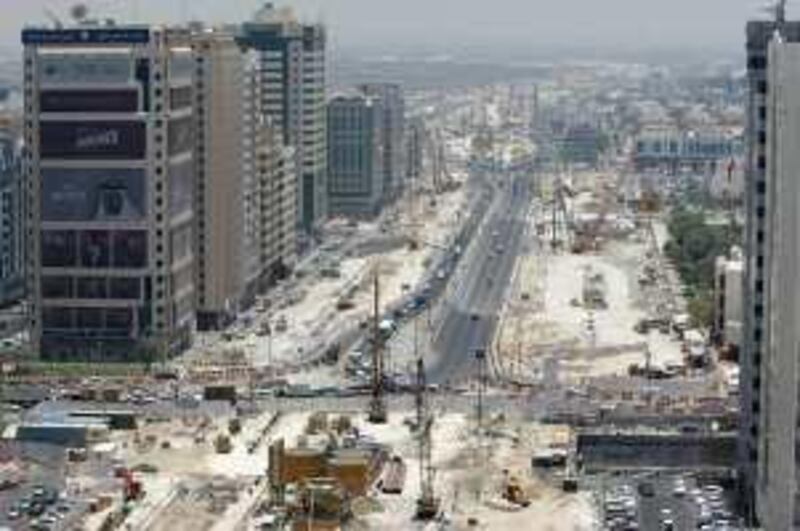The car will no longer be king under Abu Dhabi's new traffic management masterplan, and public transport and pedestrians will get much greater priority. Ivan Gale reports These days there's no peace for the residents and shop owners facing Salam Street in the centre of Abu Dhabi. Their pavements and parking strips have been turned into a construction site for the next 18 months as the Government transforms several kilometres of the road into tunnel and widened lanes.
By some accounts business has fallen more than 30 per cent for companies in the area as road closures and tangled detours have strangled the ability of customers to get into the area. Abu Dhabi Municipality has promised to find a way to make amends to the aggrieved shop owners. But it would be a mistake to think the Dh5 billion (US$1.3bn) revamp of Salam Street will be the only major roadworks project on Abu Dhabi Island.
Twenty years from now, according to the emirate's 2030 plan, Abu Dhabi will be a dynamic global capital, replete with luxury island developments and two centres, one in the Central Business District/Sowwah Island area, and another on the mainland, called the Capital District. The backbone of these plans involve an integrated mass transit system of trams, metro lines, buses and new roads totalling more than Dh300bn.
With memories of Salam Street gridlock fresh in their minds, city dwellers and businessmen may be asking will the road to 2030 be any less rocky when jackhammers again tear up the tarmac for new rail lines? Fortunately, by all accounts the answer is yes. City planners say Salam Street will be among the last of the great civil engineering projects in Abu Dhabi. Though construction on the tram and metro lines will start fairly soon, in two to three years' time, they will involve less invasive construction methods. New transport projects will be designed with a more fine-grained approach, rather than simply creating more capacity for cars.
The main reason for this is that the 2030 plan and the Salam Street project reflect very different city planning philosophies. Salam Street was undertaken by Abu Dhabi Municipality in 2006, before the 2030 plan had been created. At that time, the answer to relieving congestion was expanding dual carriageways. Salam Street will certainly do that: the eight-lane tunnel will have a capacity of more than 6,000 vehicles an hour, with travel from the Mina Zayed area to the planned Sheikh Zayed Bridge free of a single traffic light.
But the project could have been less disruptive to the community, and more opportunity taken to contact residents and warn them of the project, transport planners say. A decisive moment was reached when the Municipality hired as its project consultant Parsons International, which has played a major role in helping design Abu Dhabi's roads. Parsons proposed a "cut-and-cover" technique, which involves digging down from the surface to excavate. The Municipality chose this bid over other proposals favouring the use of a boring machine to work underground, leaving the surface intact.
At the time, boring was untested in the Gulf and considered more expensive and time consuming than cut-and-cover techniques. Only later did Dubai experiment to a limited extent with tunnelling for its metro lines. Since the project was approved, Abu Dhabi's city planning has evolved markedly. In 2007, two new agencies were established, the Urban Planning Council (UPC) and the Department of Transport (DOT), with the latter taking over most road projects from the Municipality. Both are tasked with bringing the ideals of the 2030 plan into action.
The DOT is completing a surface transport masterplan, which is geared at getting 30 to 40 per cent of motorists out of their cars and into public transport during rush hour. The UPC, for its part, is about to release a new street design manual that seems to directly contradict the philosophy behind Salam Street. Instead of wider lanes and more of them, the UPC proposes to reduce lanes on the city's roads, narrow them and add more intersections and zebra crossings to slow traffic, make room for public transport, and give pedestrians a more equal footing with the car.
While Salam Street will include an underground tunnel, the UPC is proposing that future road projects should happen on the surface level. Despite the contrast in philosophies, the two new planning agencies still view Salam Street as a key corridor. "While the principles of Plan 2030 do not generally support grade-separated streets in the city, the Salam Street Tunnel would be necessary to handle the traffic volumes coming into and passing through the central business district, once the Saadiyat Bridge would become operational," said Dr Alan Perkins, the senior planning manager of transport, infrastructure and environment at the UPC. "This will make it possible for the traffic on surface streets to be relatively calm and more pleasant to use for drivers, pedestrians and public transport users."
Future projects will be much less disruptive, the UPC said. The Abu Dhabi metro, due to open in 2016, will be mostly underground on Abu Dhabi Island. That means a tunnel-boring machine will remove a large amount of earth at both ends of the tunnels, but leave the surface streets intact. The development of the stations will witness more activity, although many of these will be constructed as part of new developments in the Capital District, Masdar, Yas Island and Saadiyat Island, Dr Perkins said.
The city's tram service, set to open in 2014, will be on the surface level, but they will mostly be built atop the central strip down dual carriageways. "Tram tracks will have some impact, such as closing of some traffic lanes, but should not involve the closing of whole sections of existing streets in the city, thereby having a minimal affect," Dr Perkins said. In a region where driving on roads is often a stomach-churning affair full of dangerous, aggressive, speeding drivers, it appears Abu Dhabi really understands the challenge. To meet the needs of a growing population, the answer is not more roads. There are wonderful examples where cities improved the quality of life for their residents after taking down ugly overpasses and double-deck freeways.
In San Francisco, a 1989 earthquake devastated the Embarcadero freeway. It was never restored, and now the area is a thriving bayside promenade with tourist attractions and a farmer's market. In Seoul, the Cheonggyecheon River, which was entombed in cement and an expressway built over it, was recently restored. The city compensated for the loss of road capacity by creating more public transport and the river is now a park and a leading leisure attraction for city residents.
These lessons are universal and apply to the UAE. Salam Street may be a necessary transport link for the city centre, but residents will be glad that forthcoming projects are done with a more human-scale approach. igale@thenational.ae





